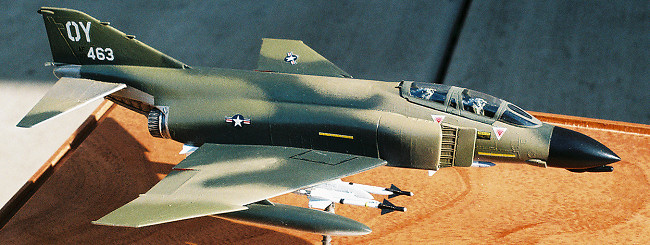
| KIT: | Monogram 1/72 F-4C/D Phantom II |
| KIT #: | ? |
| PRICE: | $Currently out of production |
| DECALS: | One option |
| REVIEWER: | Tim Cromartie |
| NOTES: |

| HISTORY |
The F-4 Phantom II (McDonnell-Douglas’ first Phantom was a Korean War era single-seat jet which resembled their later Banshee) took its maiden flight on May 27, 1958. From the outset the F-4 was a thoroughbred. Early flight tests exceeded expectations as it reached Mach 1.01; acceleration and climb-rate figures also surpassed their goals. With its two General Electric J-79 turbojets, the F-4’s amazing performance set world records for altitude (98,537 ft. on December 6, 1958) and speed (1,606.03 mph, or Mach 2.6, on November 22, 1961). It was the result of a years-long development project begun after McDonnell lost out on a contract for a Navy carrier fighter to Chance Vought in 1953. The sting of losing to what later became the F-8 Crusader drove McDonnell Douglas to begin a series of design studies tailored to meet future needs. It began with a survey of the U.S. Navy hierarchy -- the Chief of Naval Operations, the Bureau of Aeronautics, an office called Head of the Fighter Branch, the Overhaul and Repair units, and any Navy personnel willing to listen and fill out a questionnaire. The end result was the Navy’s December 17, 1958 announcement that the F4H-1, as the initial prototype was designated, had been selected as its first all-weather fighter. Poetic justice was dispensed in that the Phantom II beat out several contenders, including an advanced version of the Crusader, the F8U-3. The Phantom II was the first aircraft to make extensive use of titanium (in its keel, aft fuselage skin, engine shrouds, and part of the internal fuselage structure). It was also the first aircraft able to independently detect, intercept and destroy any target that came within radar range – other fighters of the day still needed help from surface radar units.
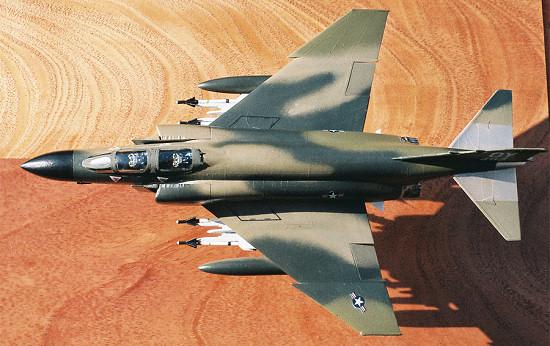 The
Navy, in conjunction with McDonnell-Douglas, embarked on a rigorous flight test
program over the next three years. The first operational Phantoms, designated
F-4B, entered service with the Navy and Marine Corps on March 25, 1961 – even
before the completion of the test program in November. The Air Force followed
suit in 1963. Over the next 25 years, a total of 17 different variants among
5,200 aircraft followed, including the gun-equipped F-4E and the Wild Weasel
series. Phantoms flew for 11 nations: Australia, Greece, Iran, Israel, Japan,
South Korea, Spain, West Germany, Great Britain, Turkey, and the United States.
The
Navy, in conjunction with McDonnell-Douglas, embarked on a rigorous flight test
program over the next three years. The first operational Phantoms, designated
F-4B, entered service with the Navy and Marine Corps on March 25, 1961 – even
before the completion of the test program in November. The Air Force followed
suit in 1963. Over the next 25 years, a total of 17 different variants among
5,200 aircraft followed, including the gun-equipped F-4E and the Wild Weasel
series. Phantoms flew for 11 nations: Australia, Greece, Iran, Israel, Japan,
South Korea, Spain, West Germany, Great Britain, Turkey, and the United States.
During its service life the Phantom saw combat in the Middle East and more extensively in Southeast Asia. It was so versatile that it quickly became a multi-role fighter, serving in Vietnam as air defense, air superiority, and escort fighters as well as fighter-bombers in battlefield and deep interdiction missions. They later performed flak suppression in the Wild Weasel role. Phantoms first saw action on August 6, 1964, when five F4-B’s of VF-142 and VF-143 off the U.S.S. Constellation made a retaliatory strike on North Vietnamese patrol boat bases following the Gulf of Tonkin incident. The first air-to-air kills occurred on June 17, 1965 when F-4B’s of VF-21 shot down two North Vietnamese MiG-17’s with Sparrow missiles.
Phantoms contended with MiG-17’s, -19’s and -21’s in Vietnam, all single-seat, gun-equipped fighters carrying AA-2 Atoll missiles similar to the heat-seeking Sidewinder. All were slower than the Phantom except for later models of the MiG-21, all were highly maneuverable, and all could out-turn the F-4. This gave the MiGs a decided advantage in dogfights, offset by the Phantom’s ability to outrun and outclimb them. The first 20mm Vulcan F-4E’s were not available until 1967, so Phantom pilots were initially dependent on missiles until their planes were field-modified with external gun pods. Missiles allowed them to destroy enemy planes from beyond visual range, but presented difficulties due to the problems with both the dependability of IFF (Identification Friend or Foe) radar with which they were used, and the reliability of both the Sidewinders and Sparrows, which sometimes led to firing them in pairs to increase chances of a hit. Adopting hit-and-run tactics to emphasize the Phantom’s strengths, rather than “fighting the MiG’s fight,” Phantom pilots accounted for 42 destroyed MiGs in Vietnam, contributing their fair share of the impressive kill ratio of 10-to-1 in favor of the Americans.
 Ultimately
the biggest hindrance to Phantom drivers in Vietnam may have been the political
constraints of the war, complicating their lives in the form of “Rules of
Engagement.” Air-to-air kills were OK, for example, but enemy planes could not
be hit if parked on the ground. One Phantom pilot, Air Force Captain Bill
Jenkins, commented, “The Rules of Engagement were such that I sometimes felt I
needed a lawyer in the back seat instead of a WSO!”.
Ultimately
the biggest hindrance to Phantom drivers in Vietnam may have been the political
constraints of the war, complicating their lives in the form of “Rules of
Engagement.” Air-to-air kills were OK, for example, but enemy planes could not
be hit if parked on the ground. One Phantom pilot, Air Force Captain Bill
Jenkins, commented, “The Rules of Engagement were such that I sometimes felt I
needed a lawyer in the back seat instead of a WSO!”.
One anecdote from the Middle East points up the Phantom’s true worth. In 1970, Egyptian President Nasser traveled to Moscow to demand from his Soviet allies a Russian fighter able to match the Phantoms the U.S. had sold Israel, which had been mauling the MiG-equipped Egyptian Air Force in a series of incursions across the Nile River. After much argument, the embarrassed Russians had to admit they had no such aircraft.
Specifications (F-4E)
Wingspan: 38 ft., 4 7/8 in.
Height: 16 ft., 5 ½ in.
Length: 62 ft., 11 ¾ in.
Powerplant: 2 General Electric J-79 Turbojets of 17,900 lbs. thrust, with afterburners
Service Ceiling: 70,000 feet
Rate of Climb: 28,000 ft. per minute
Range: 900 miles with combat load; 2,300 miles with external fuel tanks
Maximum Speed: Mach 2.4 (1,584 mph at 48,000 feet)
Armament: 20mm Vulcan cannon, variety of underwing stores
| THE KIT |
The
Monogram kit, an F-4C/D released in 1985, is molded in olive drab with raised
panel lines and has very crisp detail throughout, particularly the cockpit.
This excellent quality was typical of Monogram’s new releases in the two decades
preceding their 1997 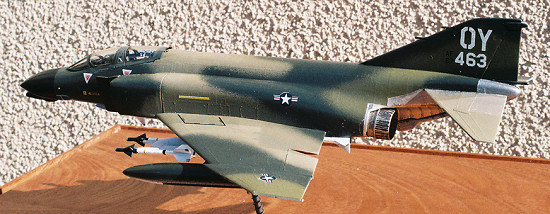 merger with Revell. The F-4C and D were originally only
missile-equipped, due to prevailing air combat theory in the late 1950’s – gun
pods were later retrofitted when combat experience in Vietnam proved guns were
not in fact obsolete. For the purists out there who believe a fighter isn’t a
fighter unless it has a gun, a centerline 20mm gun pod is provided – I opted not
to use it, as it would have complicated my mounting arrangement, also I’ve read
that the gun pod’s design led to additional drag, hampering performance --
unique among the Phantom’s underslung weaponry. The kit also comes with
underwing fuel tanks, electronic countermeasure pods, and a full complement of
four AIM-9 Sidewinder and four AIM-7 Sparrow missiles -- standard armament for a
Vietnam-era Phantom. Decals are provided for an Air Force F-4D of the 555th
Tactical Fighter Squadron.
merger with Revell. The F-4C and D were originally only
missile-equipped, due to prevailing air combat theory in the late 1950’s – gun
pods were later retrofitted when combat experience in Vietnam proved guns were
not in fact obsolete. For the purists out there who believe a fighter isn’t a
fighter unless it has a gun, a centerline 20mm gun pod is provided – I opted not
to use it, as it would have complicated my mounting arrangement, also I’ve read
that the gun pod’s design led to additional drag, hampering performance --
unique among the Phantom’s underslung weaponry. The kit also comes with
underwing fuel tanks, electronic countermeasure pods, and a full complement of
four AIM-9 Sidewinder and four AIM-7 Sparrow missiles -- standard armament for a
Vietnam-era Phantom. Decals are provided for an Air Force F-4D of the 555th
Tactical Fighter Squadron.
| CONSTRUCTION |
With the exception of the underwing pylons for the Sidewinder missiles, this kit was a dream to build, no major fit problems and little filler required. It has an amazing amount of cockpit detail for a 1/72nd scale kit, featuring separate seat backs, control columns, and instrument panels with raised detail for both the pilot and radar intercept operator.
Assembly
begins with the cockpit, which consists of a detailed tub and the individual
components mentioned above. The most intricate work at this stage is
dry-brushing the cockpit instrument panels to highlight the raised detail so
lavishly provided – in my 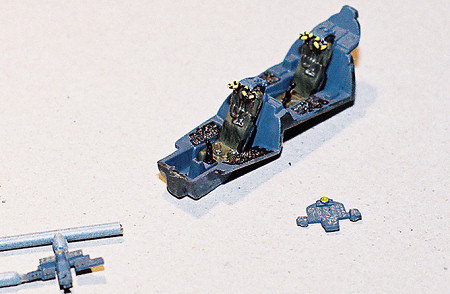 experience a rarity in 1/72nd scale. From
there you cement in the cockpit assembly, glue the fuselage halves together,
then move on to adding the wings, a simple three-piece assembly. The forward
section of the air intakes are two separate pieces, consisting of a ramp and the
leading edge scoop of the intake itself. The Revell F-4E version of the Phantom
has three-sided air intake scoops, which are ideal and require little to no
clean-up. However, Monogram’s kit has two-sided intakes, with the side in line
with the plane’s belly molded as part of the single-piece bottom half of the
wing. This requires putty and sanding to hide the resulting seam, which had a
noticeable gap on both sides and was initially quite visible. This is the one
structural defect with the kit, but is remedied with a little effort.
experience a rarity in 1/72nd scale. From
there you cement in the cockpit assembly, glue the fuselage halves together,
then move on to adding the wings, a simple three-piece assembly. The forward
section of the air intakes are two separate pieces, consisting of a ramp and the
leading edge scoop of the intake itself. The Revell F-4E version of the Phantom
has three-sided air intake scoops, which are ideal and require little to no
clean-up. However, Monogram’s kit has two-sided intakes, with the side in line
with the plane’s belly molded as part of the single-piece bottom half of the
wing. This requires putty and sanding to hide the resulting seam, which had a
noticeable gap on both sides and was initially quite visible. This is the one
structural defect with the kit, but is remedied with a little effort.
The bulk of the work comes with painting, particularly if you decide to employ a Vietnam-era camouflage scheme. There is sufficient weaponry and cockpit detail to make you think twice before parting with any additional cash for an aftermarket set of any kind, a key reason why I built this kit OOB.
 A
couple of issues relate to the missiles. First are the aforementioned underwing
pylons for the Sidewinders. The directions are not sufficiently clear as to how
the three-part assembly -- consisting of a pylon and two rails for each wing --
should be assembled, as there are pins and machined grooves that can be
difficult to align properly using what in this instance are the not-so-well
illustrated instructions. If you are not careful, it’s possible to cement the
rails on backwards or upside down, and the fit on this one assembly is below
standard. Second, the Sparrow missiles, which are nestled in individually
recessed troughs at four points along the underside of the fuselage, each have a
machined circular depression in them which did not appear on the actual AIM-9
missiles. No big deal, except that the depressions are deep enough that you
cannot sand them down without creating a slight bottle-neck look in the
missiles. If they had to have these machined defects in the mold, better to
have them on the opposite side of the missiles, the side glued against the
fuselage and hidden from view on the completed model.
A
couple of issues relate to the missiles. First are the aforementioned underwing
pylons for the Sidewinders. The directions are not sufficiently clear as to how
the three-part assembly -- consisting of a pylon and two rails for each wing --
should be assembled, as there are pins and machined grooves that can be
difficult to align properly using what in this instance are the not-so-well
illustrated instructions. If you are not careful, it’s possible to cement the
rails on backwards or upside down, and the fit on this one assembly is below
standard. Second, the Sparrow missiles, which are nestled in individually
recessed troughs at four points along the underside of the fuselage, each have a
machined circular depression in them which did not appear on the actual AIM-9
missiles. No big deal, except that the depressions are deep enough that you
cannot sand them down without creating a slight bottle-neck look in the
missiles. If they had to have these machined defects in the mold, better to
have them on the opposite side of the missiles, the side glued against the
fuselage and hidden from view on the completed model.
Attaching the tail planes is next. A note about the sequence of construction
here, which really should be tailored around the painting, particularly if you
are doing a camouflaged version of any Phantom: Paint the tail planes
separately from the rest of the kit, then cement them to the fuselage only after
all major painting is complete. The reason is that extensive masking is
req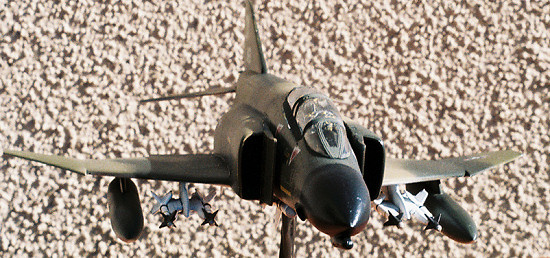 uired throughout the aft area of the fuselage to properly paint both the
surrounding camouflage, and the titanium or natural metal areas of the engines
and fuselage below and behind the tail planes. In addition, the inboard section
of the tail planes themselves should be a natural metal finish, whereas the
outboard sections are part of the overall paint scheme. All this requires
repeated masking. Given the stress the tail planes are subjected to in masking
them for successive paintings after they’re cemented to the fuselage, in
hindsight it is better to paint them completely first, then glue them on after
the painting of the rear fuselage is complete. The spars on these pieces simply
are not strong enough to support the tail planes through successive maskings,
and the one on the port side broke off during painting.
uired throughout the aft area of the fuselage to properly paint both the
surrounding camouflage, and the titanium or natural metal areas of the engines
and fuselage below and behind the tail planes. In addition, the inboard section
of the tail planes themselves should be a natural metal finish, whereas the
outboard sections are part of the overall paint scheme. All this requires
repeated masking. Given the stress the tail planes are subjected to in masking
them for successive paintings after they’re cemented to the fuselage, in
hindsight it is better to paint them completely first, then glue them on after
the painting of the rear fuselage is complete. The spars on these pieces simply
are not strong enough to support the tail planes through successive maskings,
and the one on the port side broke off during painting.
With the separate wing flaps, I recommend the opposite approach: Be sure to cement them to the wings before painting, especially if you decide on a camouflage paint scheme. Otherwise you create more work for yourself later with the airbrush.
The only other note is that the canopy, which I masked prior to air brushing using scotch tape – a successful first attempt, as I usually paint canopies freehand – is slightly off center on my Phantom. Fortunately, it is only noticeable after careful study and does not detract from the final look of the model. This may be unique to my individual example, or could be a slight defect in the molding.
| COLORS & MARKINGS |
I painted the Phantom’s camouflage scheme using a combination of Tamiya acrylics (Khaki XF-49 and Dark Green XF-61) and Model Master enamels (Olive Green, and Flat Black for the radome). The underside is a Polly Scale acrylic, RLM 63 - German Light Grey F505304. All missiles sport a base color of Tamiya Gloss White X-2. I used Alclad Pale Burnt Metal for the metallic area in and around the engines. The masking required, particularly for this area, made painting a time-consuming process, but its well worth the effort to get the right look on the finished kit.
| CONCLUSIONS |
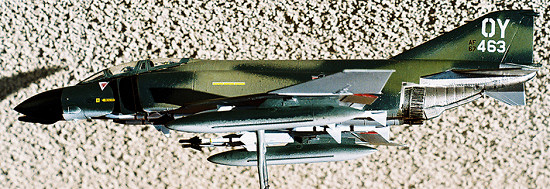 The
last 1/72nd Phantom kit I did was Revell’s F-4E back in the late
1970’s, and I found this kit vastly superior, mainly for its far better fit,
more precise molding overall, and great cockpit detail. However, the older
Revell kit provides detailed performance specifications, whereas the Monogram
kit does not. Today’s model companies really need to reverse this “dumbing
down” trend – modelers shouldn’t have to do research just to get basic specs on
a subject.
The
last 1/72nd Phantom kit I did was Revell’s F-4E back in the late
1970’s, and I found this kit vastly superior, mainly for its far better fit,
more precise molding overall, and great cockpit detail. However, the older
Revell kit provides detailed performance specifications, whereas the Monogram
kit does not. Today’s model companies really need to reverse this “dumbing
down” trend – modelers shouldn’t have to do research just to get basic specs on
a subject.
The Monogram decals are great except for the national insignia, which are slightly out of register. Given that Air Force national insignia are significantly smaller than their Navy or Marine Corps counterparts, this isn’t a major defect, but I’d still recommend substituting a good aftermarket set. This is a great kit for Phantom lovers, and can still be found despite the fact that it’s out of production. Even with the few deficiencies I’ve described, this is a gem among 1/72nd scale kits. Until now I’ve built relatively few of Monogram’s later offerings under its original label. This kit is so good it made me wonder why the merger with Revell ever happened.
| REFERENCES |
The Encyclopedia of World Air Power, Crescent Books, 1980; Modern Fighting Aircraft, Volume 4: F-4, by Doug Richardson and Mike Spick, Salamander Books Limited, 1984; Revell 1/72 F-4E Phantom II instructions.
March 2006
If you would like your product reviewed fairly and quickly by a site that has over 300,000 visitors a month, please contact me or see other details in the Note to Contributors.